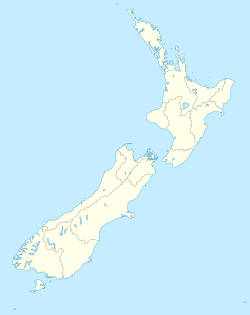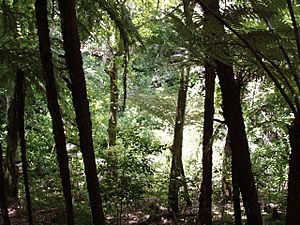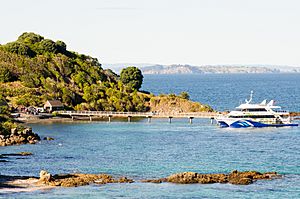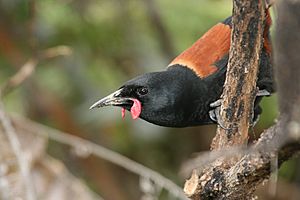Tiritiri Matangi Island facts for kids
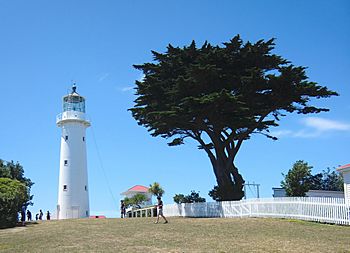
Tiritiri Matangi Lighthouse and ranger station.
|
|
| Geography | |
|---|---|
| Location | Hauraki Gulf |
| Coordinates | 36°36′S 174°53′E / 36.60°S 174.89°E |
| Archipelago | New Zealand archipelago |
| Area | 2.2 km2 (0.85 sq mi) |
| Administration | |
|
New Zealand
|
|
| Demographics | |
| Population | 0 |
Tiritiri Matangi Island is a special island in New Zealand. It's located in the Hauraki Gulf, about 3.4 kilometers (2.1 miles) east of the Whangaparāoa Peninsula. This island is a protected nature reserve. It's famous for its amazing bird life. You can find rare birds like takahē, North Island kōkako, and kiwi here.
The island is managed by a group called Supporters of Tiritiri Matangi Incorporated. They work with the Department of Conservation. Many people visit the island each year, usually between 30,000 and 32,000 visitors. This number is the most allowed to protect the island.
The name "Tiritiri Matangi" comes from the Māori language. It means "tossed by the wind." People often just call it Tiritiri. In Māori stories, the island is believed to be a part of an old fishing net used by ancestors.
Contents
Island Geography
Tiritiri Matangi Island is part of the Hibiscus Coast. It lies east of the Whangaparāoa Peninsula. The island is made of very old rock called greywacke.
Island Climate
The weather on Tiritiri Matangi is mild. It has warm summers and cool winters. Rain falls throughout the year.
| Climate data for Tiri Tiri Lighthouse (1991–2020) | |||||||||||||
|---|---|---|---|---|---|---|---|---|---|---|---|---|---|
| Month | Jan | Feb | Mar | Apr | May | Jun | Jul | Aug | Sep | Oct | Nov | Dec | Year |
| Mean daily maximum °C (°F) | 22.4 (72.3) |
22.9 (73.2) |
21.7 (71.1) |
19.5 (67.1) |
17.3 (63.1) |
15.1 (59.2) |
14.2 (57.6) |
14.5 (58.1) |
15.6 (60.1) |
16.9 (62.4) |
18.7 (65.7) |
20.7 (69.3) |
18.3 (64.9) |
| Daily mean °C (°F) | 19.5 (67.1) |
20.1 (68.2) |
19.0 (66.2) |
17.2 (63.0) |
15.0 (59.0) |
12.9 (55.2) |
11.9 (53.4) |
12.1 (53.8) |
13.1 (55.6) |
14.3 (57.7) |
15.9 (60.6) |
17.9 (64.2) |
15.7 (60.3) |
| Mean daily minimum °C (°F) | 16.6 (61.9) |
17.2 (63.0) |
16.3 (61.3) |
14.9 (58.8) |
12.7 (54.9) |
10.7 (51.3) |
9.6 (49.3) |
9.7 (49.5) |
10.6 (51.1) |
11.7 (53.1) |
13.1 (55.6) |
15.1 (59.2) |
13.2 (55.8) |
| Average rainfall mm (inches) | 61.8 (2.43) |
68.6 (2.70) |
86.7 (3.41) |
72.3 (2.85) |
91.9 (3.62) |
101.1 (3.98) |
104.0 (4.09) |
98.0 (3.86) |
78.5 (3.09) |
75.8 (2.98) |
58.4 (2.30) |
76.8 (3.02) |
973.9 (38.33) |
| Source: NIWA | |||||||||||||
Island History
Early Human Use
The first people to live on Tiritiri Matangi were the Māori. The Kawerau tribe settled there first. Later, the Ngāti Pāoa tribe also lived on the island. Both tribes used the island for shark fishing. The Kawerau tribe stayed until 1821. They had to leave when Hongi Hika attacked from the north. There were two Māori forts, called pā, on the island.
European settlers arrived in the early 1800s. In 1841, the Ngāti Pāoa tribe sold the land to the Crown (the government). When the Kawerau tribe returned, there were disagreements about who owned the island. In 1867, the Māori Land Court decided the Crown owned it.
Lighthouse and Farming
A lighthouse was built on the island in 1864. It is still working today. In 1956, a very powerful light was put in the lighthouse. It was one of the strongest lights in the world at that time. It could shine for 58 nautical miles (about 107 kilometers or 66 miles).
A family named Hobbs farmed the island from 1863 until 1971. After their farming lease ended, the island was put under the care of the Hauraki Gulf Maritime Park Board.
Island Regeneration and Sanctuary
Tiritiri Matangi was once covered in forests. But by the mid-1900s, it had become mostly farmland. In 1984, a huge project began to bring the native forest back. Over 250,000 native plants have been grown and planted on the island.
The island was chosen for this project because it was a safe place. It didn't have many introduced animals that hunt birds, like stoats. These animals were common on the mainland. At first, the island didn't have much food or homes for native birds. People hoped the forest would grow back naturally. However, it was growing very slowly because the island was covered in thick grass.
So, a plan was made to start a plant nursery. They collected seeds and cuttings to help the small patches of forest grow bigger. They chose Pōhutukawa trees to plant first. These trees would provide places for birds to rest. The birds would then drop seeds from the fruits they ate, helping other native trees grow around the pōhutukawa.
In 1993, another important step was taken. All the Polynesian rats, also called kiore, were removed from the island. These rats were eating young plants and competing with birds for food. Getting rid of them helped the plants and birds a lot.
Many different kinds of birds live on or near the island. Eighty-seven species have been seen! Eleven native bird species have been moved to the island as part of the restoration project. These include the red-crowned parakeet (kākāriki), North Island saddleback (tīeke), brown teal (pāteke), whitehead (pōpokotea), takahē, little spotted kiwi, stitchbird (hihi), North Island kōkako, fernbird (mātātā), North Island tomtit (miromiro), and rifleman (titipounamu).
Other animals have also been moved to the island. In 2003, 60 tuatara were brought there. Duvaucel's gecko arrived in 2006, and a large insect called wetapunga in 2011. Some non-native animals, like the Australian brown quail, are still present.
The success of Tiritiri Matangi's conservation project has inspired similar projects. Other islands in the Hauraki Gulf, like Motuihe, Motuora, and Motutapu, are now also working to restore their native wildlife. The nearby Shakespear Regional Park on the Whangaparāoa Peninsula also became a safe place for animals in 2011. This helps birds from Tiritiri move to the mainland.
A ferry takes visitors to Tiritiri Matangi from the Auckland Ferry Terminal and Gulf Harbour. Guided tours are available. It's a very popular place for day trips. Many trips are fully booked. Visitors love hearing the intense birdsong, which is rare on the mainland. Many thousands of volunteers have also helped with conservation work on the island.
See also


